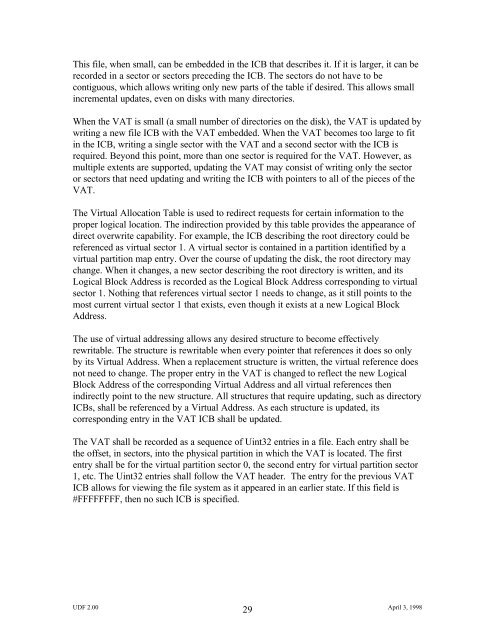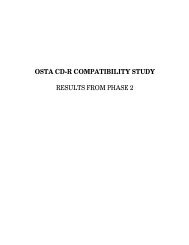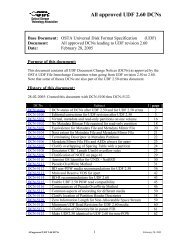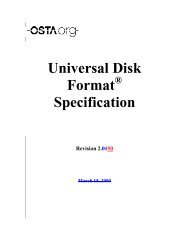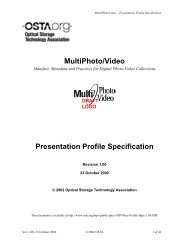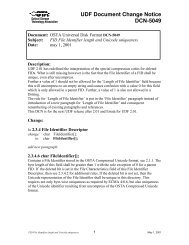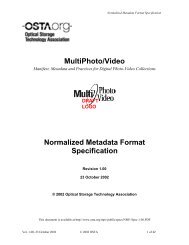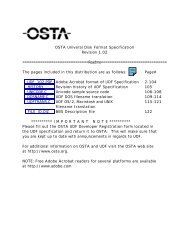UDF 2.00 - OSTA - Optical Storage Technology Association
UDF 2.00 - OSTA - Optical Storage Technology Association
UDF 2.00 - OSTA - Optical Storage Technology Association
You also want an ePaper? Increase the reach of your titles
YUMPU automatically turns print PDFs into web optimized ePapers that Google loves.
This file, when small, can be embedded in the ICB that describes it. If it is larger, it can be<br />
recorded in a sector or sectors preceding the ICB. The sectors do not have to be<br />
contiguous, which allows writing only new parts of the table if desired. This allows small<br />
incremental updates, even on disks with many directories.<br />
When the VAT is small (a small number of directories on the disk), the VAT is updated by<br />
writing a new file ICB with the VAT embedded. When the VAT becomes too large to fit<br />
in the ICB, writing a single sector with the VAT and a second sector with the ICB is<br />
required. Beyond this point, more than one sector is required for the VAT. However, as<br />
multiple extents are supported, updating the VAT may consist of writing only the sector<br />
or sectors that need updating and writing the ICB with pointers to all of the pieces of the<br />
VAT.<br />
The Virtual Allocation Table is used to redirect requests for certain information to the<br />
proper logical location. The indirection provided by this table provides the appearance of<br />
direct overwrite capability. For example, the ICB describing the root directory could be<br />
referenced as virtual sector 1. A virtual sector is contained in a partition identified by a<br />
virtual partition map entry. Over the course of updating the disk, the root directory may<br />
change. When it changes, a new sector describing the root directory is written, and its<br />
Logical Block Address is recorded as the Logical Block Address corresponding to virtual<br />
sector 1. Nothing that references virtual sector 1 needs to change, as it still points to the<br />
most current virtual sector 1 that exists, even though it exists at a new Logical Block<br />
Address.<br />
The use of virtual addressing allows any desired structure to become effectively<br />
rewritable. The structure is rewritable when every pointer that references it does so only<br />
by its Virtual Address. When a replacement structure is written, the virtual reference does<br />
not need to change. The proper entry in the VAT is changed to reflect the new Logical<br />
Block Address of the corresponding Virtual Address and all virtual references then<br />
indirectly point to the new structure. All structures that require updating, such as directory<br />
ICBs, shall be referenced by a Virtual Address. As each structure is updated, its<br />
corresponding entry in the VAT ICB shall be updated.<br />
The VAT shall be recorded as a sequence of Uint32 entries in a file. Each entry shall be<br />
the offset, in sectors, into the physical partition in which the VAT is located. The first<br />
entry shall be for the virtual partition sector 0, the second entry for virtual partition sector<br />
1, etc. The Uint32 entries shall follow the VAT header. The entry for the previous VAT<br />
ICB allows for viewing the file system as it appeared in an earlier state. If this field is<br />
#FFFFFFFF, then no such ICB is specified.<br />
<strong>UDF</strong> <strong>2.00</strong> April 3, 1998<br />
29


